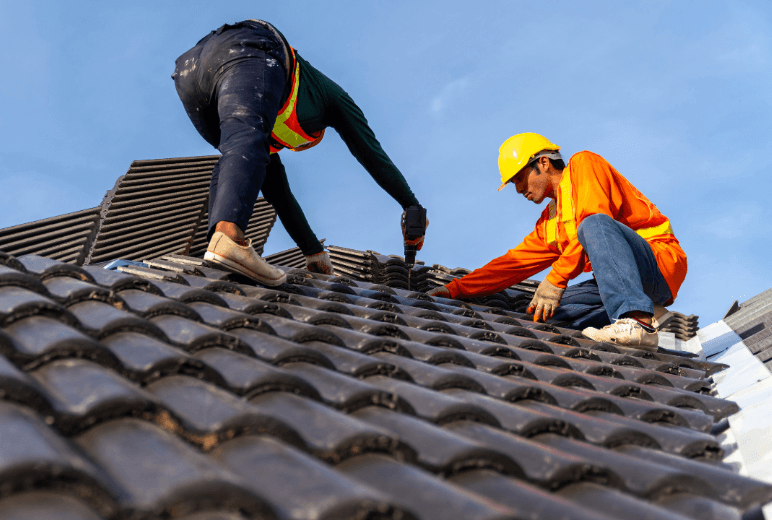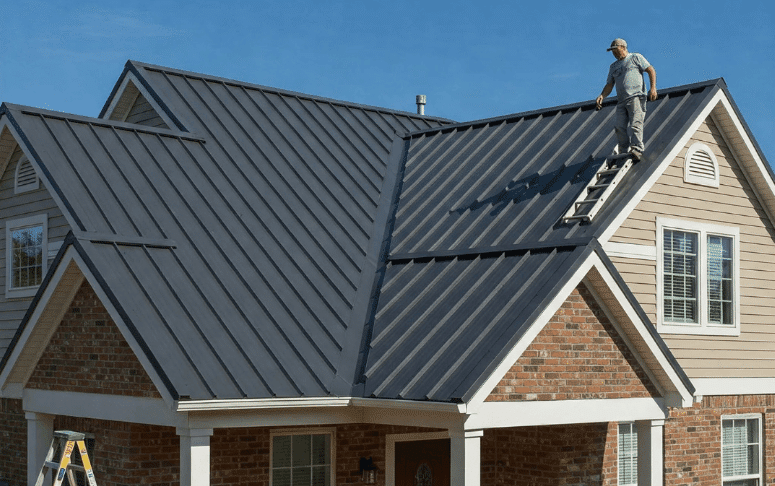Experiencing a storm can be overwhelming, especially when it leaves your home with a damaged roof. The immediate aftermath can feel chaotic, but knowing how to handle emergency roof repairs can save you time, money, and further damage to your property.
In this comprehensive guide, we’ll walk you through the essential steps to fix a damaged roof after a storm, ensuring your home is safe and secure for the future.
Conduct a Visual Inspection
Start by conducting a visual inspection from the ground. Look for visible signs of damage, such as missing or broken shingles, dents, or cracks. Use binoculars to get a closer look if necessary. Pay attention to areas around chimneys, vents, and skylights, as these are common trouble spots.
Inspect the Attic
Next, check your attic for any signs of leaks or water damage. Look for wet insulation, water stains, or mold growth. These indicators suggest that the roof’s integrity has been compromised. Use a flashlight to thoroughly inspect corners and hidden areas.
The presence of daylight peeking through the roof is a sure sign of a breach that needs immediate attention.
Document the Damage
Take photos and notes of all the visible damage. This documentation will be helpful for insurance purposes and when consulting with roofing repair services. Ensure you capture images from multiple angles and distances for clarity.
Evaluate the Structural Impact
Assess whether the damage has affected the structural integrity of your home. Look for signs of sagging ceilings, warped walls, or doors that no longer close properly. These can be indicators of more serious damage that requires immediate professional attention.
Consider Safety Precautions
While assessing the damage, always prioritize safety. Avoid climbing onto a roof that seems unstable or slippery. Consider using drones for a safer inspection from above. If in doubt, consult professionals to perform a detailed assessment without putting yourself at risk.
Temporary Emergency Roof Repair
If the damage is severe and you cannot get a roofing contractor immediately, you may need to perform temporary emergency repairs to prevent further damage to your home. These temporary measures can be crucial in protecting your home from the elements while you arrange for professional repairs.
Cover the Damaged Area
Use a tarp or heavy-duty plastic to cover any exposed areas. Secure the covering with nails or staples, ensuring it is tightly fastened to prevent wind from lifting it. This temporary fix will protect your home from rain and debris until professional help arrives. Ensure the tarp is large enough to extend over the roof’s peak to prevent water from seeping underneath.
Clear Debris
Remove any debris, such as branches or leaves, from the roof. Be cautious and ensure your safety when climbing onto the roof. If the roof is too steep or slippery, it’s best to leave this task to the professionals. Clearing debris helps prevent additional weight and water pooling, which can worsen the damage.
Seal Leaks Temporarily
For minor leaks, use roof sealant or caulking to temporarily seal the breach. Apply the sealant generously over the cracked or broken areas. This can provide a short-term solution until more permanent repairs can be made. Be sure to follow the instructions on the sealant for the best results.
Reinforce Weak Spots
Identify any weak spots that might give way under pressure. Reinforce these areas with plywood or another sturdy material if possible. This can prevent further damage from occurring until repairs are made. Ensure any reinforcements are securely fastened to avoid causing additional damage.
Monitor Weather Conditions
Stay informed about upcoming weather conditions. If more storms are forecasted, reinforce the temporary repairs to withstand additional stress. Taking preemptive measures can minimize further damage and ensure your home remains protected.
Roof Repair Process

Once you’ve chosen a roofing contractor, they will begin the repair process. Understanding the steps involved will help you stay informed and ensure the work is done correctly. A well-executed repair process can restore your roof’s integrity and extend its lifespan.
Removing Damaged Materials
The first step in the repair process is removing any damaged materials. This includes broken or missing shingles, damaged flashing, or underlayment. The roofing contractor will carefully remove these materials to prevent further damage to the roof structure. Proper disposal of old materials is also important to maintain environmental standards.
Repairing or Replacing Shingles
Depending on the extent of the damage, the contractor will repair or replace the damaged shingles. They will ensure that the new shingles match the existing ones in color and style, maintaining the roof’s appearance. Proper installation is crucial to prevent future leaks and weather damage.
Fixing Flashing and Seals
The contractor will inspect and repair any damaged flashing around chimneys, vents, or skylights. They will also reseal any areas where water might penetrate the roof, such as around pipes or seams. Proper sealing is essential to ensure long-term protection against water intrusion.
Inspecting and Reinforcing the Roof Structure
In cases of severe damage, the roofing contractor may need to inspect and reinforce the underlying roof structure. This could involve repairing or replacing damaged rafters, trusses, or decking to ensure the roof’s stability. Reinforcement may also involve adding additional support to meet current building standards.
Final Inspection and Cleanup
Once the repairs are complete, the contractor will perform a final inspection to ensure everything is in order. They will also clean up any debris or materials left behind, leaving your property neat and tidy. A thorough final inspection ensures that no minor issues are overlooked.
Reviewing the Work and Warranty
After the repairs, review the work done with the contractor. Ensure all agreed-upon repairs were completed to your satisfaction. Discuss the warranty terms and any maintenance recommendations provided by the contractor. Understanding your warranty coverage is crucial for future peace of mind.
Preventing Future Roof Damage

While storms are unavoidable, there are steps you can take to minimize the risk of roof damage in the future. Proactive measures can enhance your roof’s resilience and protect your home from severe weather impacts.
Regular Roof Maintenance
Schedule regular roof inspections and maintenance with a professional roofing company. They can identify potential issues before they become significant problems, extending the life of your roof. Regular maintenance can include cleaning gutters, checking for loose shingles, and inspecting seals.
Clip back branches
Keep trees and branches trimmed away from your roof. Overhanging branches can cause damage during storms and allow debris to accumulate on your roof. Regular trimming reduces the risk of physical damage and helps maintain the roof’s cleanliness.
Install Impact-Resistant Shingles
Consider upgrading to impact-resistant shingles if your area is prone to severe weather. These shingles are designed to withstand hail, wind, and other harsh conditions, providing added protection for your home. Consult with a roofing expert to determine the best materials for your specific location.
Enhance Roof Ventilation
Ensure your roof has adequate ventilation to prevent moisture buildup and heat damage. Proper ventilation can extend the lifespan of your roof by reducing strain on its materials. Consult with a professional to assess and improve your roof’s ventilation system.
Educate Yourself on Weather Preparedness
Stay informed about weather patterns and warnings in your area. Being proactive in preparing your home for severe weather can prevent unnecessary damage. Consider investing in weatherproofing measures and emergency supplies to safeguard your home.
Conclusion
Storm damage can be overwhelming, but taking clear, timely steps can make the recovery process much smoother. Assess the damage, secure temporary fixes, and connect with a trusted local roofing contractor to restore your home quickly and safely.
If you need storm damage roof repair in Ham Lake, contact the experts at Timberline Roofing and Contracting to get a quote. Our experienced team is ready to help you recover with dependable service and lasting results. We’re here to guide you through every step of the process.

